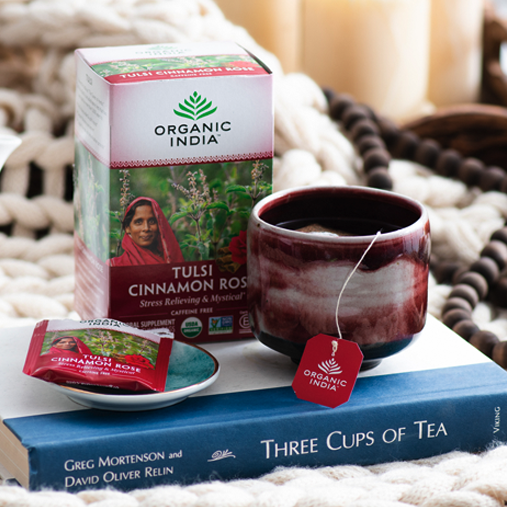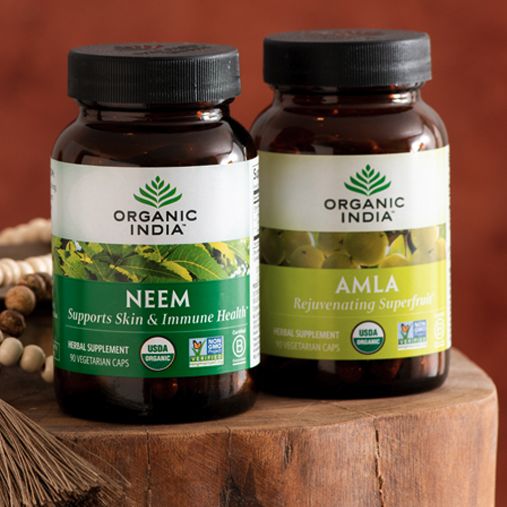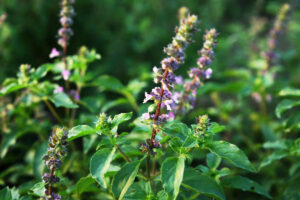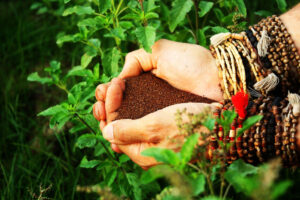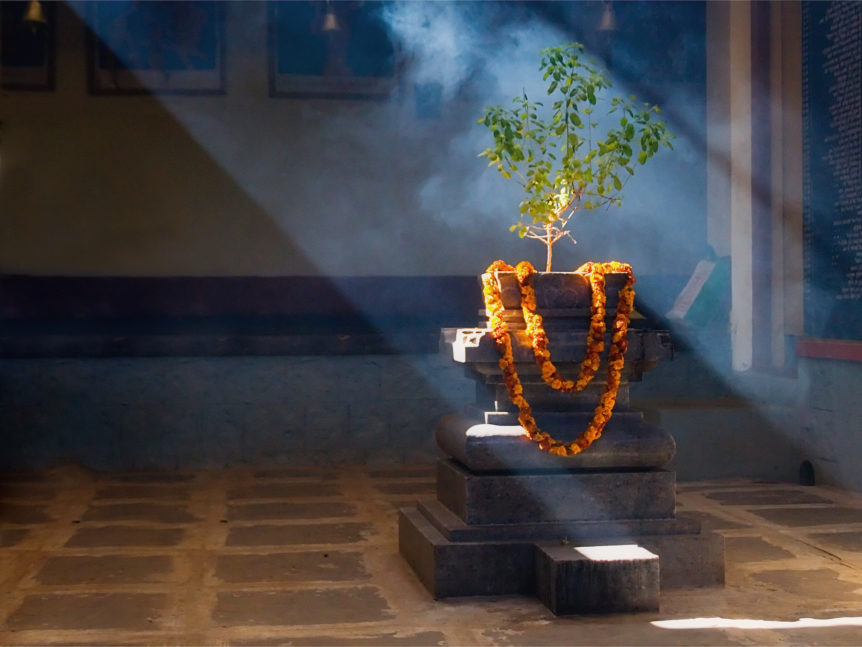Back
The idea of a plant’s sacredness stems from the traditional understanding of our connection to the entirety of the universe, including the herbs that sustain and nurture life. Indian conservationist Bharti Chhibber explains, “Religion protects and nurtures nature. If we take a look at Hinduism, we worship the sun, wind, land, trees, plants, and water, which is the very base of human survival.” Since the earliest times, healers have known that we human beings are inseparable from all else that arises out of Mother Earth. Our sacred relationship with plants, and the holy status conferred upon them, speaks to a greater spiritual understanding of who we are as part and parcel of the natural world — a lesson that has been thankfully rekindled by regenerative farmers, environmentalists, traditional healers, ethnobotanists, and others. Taking its place upon the throne of the most revered plants in Indian culture is Tulsi, known as Queen of the Herbs.
Inviting a Goddess Into the Home
Tulsi is known to Hindus as the earthly manifestation of Lakshmi, the esteemed goddess of wealth and good fortune, who arose from the depths of the oceans after the gods churned them to rid the world of demons. Devotees of Hinduism believe that on full moon nights Lakshmi visits each home and blesses the inhabitants with wealth and prosperity. The goddess is the object of worship during several holidays, including Diwali, the festival of lights celebrated by Hindus, Jains, and Sikhs. Goddess Lakshmi is most often depicted holding a lotus flower, a symbol of birth, resurrection, good fortune, and enlightenment.
Like Lakshmi, Tulsi brings blessings into the home, which is why the plant is displayed prominently in front of doors, atria, and foyers across the Indian continent — and wherever Hindus have settled.
Buildings and shrines displaying Tulsi plants are sometimes considered sites of pilgrimage, and the plants are often grown in Vrindavans — raised cuboid stone or brick structures, commonly featured in the middle of a courtyard or in front of a residence or temple.
Tulsi’s Healing Potential
The sacred Tulsi plant is regarded as the threshold between heaven and earth. A traditional prayer suggests that the creator-god Brahma dwells in its branches and that Hindu pilgrimage sites reside in, and the river Ganges flows through, its roots. The prayer recognizes that all deities may be found in Tulsi’s stem and leaves; and that the Hindu scriptures — the Vedas — are nestled in its upper branches. Like Lakshmi, Tulsi, is considered a female deity that is well-rooted as protector and nurturer of the home and its occupants.
Tulsi bestows an array of benefits onto its worshippers, but has also found a prominent place among the works of scientific researchers who have identified many of the plant’s most celebrated nutrients, ranging from antioxidants to polyphenols. Tulsi is also regarded in Ayurveda as an “elixir of life” and is believed to promote longevity.
Scientists, herbalists, and nutritionists have discovered that this botanical is potent in vitamin C and A, minerals that include calcium, zinc and iron, and chlorophyll — along with many other phytonutrients. One of Tulsi’s most prominent roles is as a well-known adaptogen, balancing various bodily processes that would otherwise lead to the myriad negative effects of stress.
Marc Maurice Cohen, School of Health Sciences, RMIT University, Australia, reported that Tulsi also protects organs and tissues against chemical stress from industrial pollutants and heavy metals, as well as the effects of physical stress from prolonged physical exertion, ischemia (restriction of oxygen), physical restraint, and exposure to cold and excessive noise. Cohen notes that Tulsi has also been shown to counter metabolic stress by balancing blood sugar, blood pressure, and lipid levels.
Tulsi also helps people cope with psychological stress and exerts positive effects on memory and cognitive function. It has also been used as a traditional plant that eases depression and anxiety. While traditional Ayurvedic healers consider Tulsi to be one of the best plants to balance the mind, body, and spirit, modern researchers have focused on its antibacterial, antiviral, antifungal, anti-inflammatory, neuro-protective, and cardio-protective properties, finding it an overwhelmingly impressive natural treatment for an array of ailments.
Where Tradition Meets Science
Tulsi was mentioned by the ancient Indian healer Charaka in the Ayurvedic text Charaka Samhita as one of Ayurveda’s most celebrated healing plants, capable of addressing an array of ailments. Celebrated “medicine hunter” Chris Kilham, who has conducted medicinal plant research in more than 45 countries, explains that while Tulsi’s history is steeped in religion and mythology, it has also been used in several ancient systems of medicine, including Ayurveda, Greek, Roman, and Siddha for thousands of years. When healers, Hindus, and botanists refer to Tulsi as sacred or holy, it is both for the plant’s elevated status as a goddess, as well as for its strong connection with the human organism that allows it to exhibit time-tested — and now scientifically validated — healing benefits.

